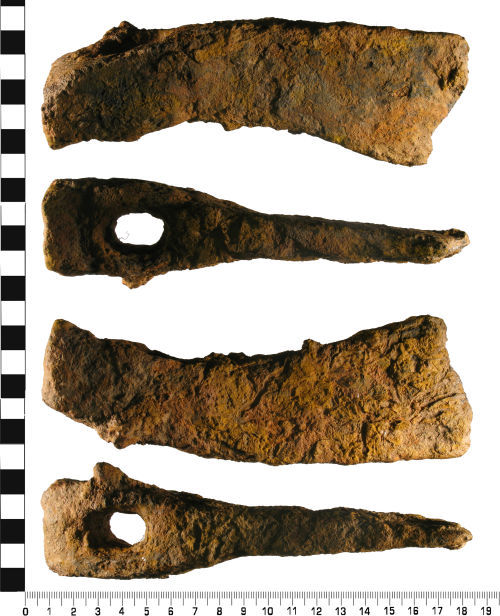
Rights Holder: Birmingham Museums Trust
CC License: ![]()
Image use policy
Our images can be used under a CC BY attribution licence (unless stated otherwise).
AXE
Unique ID: WMID-B6FD25
Object type certainty: Certain
Workflow
status: Awaiting validation ![]()
An incomplete, hand made, iron axe head, of possible Roman dating (AD 43 to AD 410).
It has a curved and flaring blade that has a triangular longitudinal section. The axe expands to the pole / shaft end, which curves downwards, is flat and rectangular in form. The eye through which the axe would have originally have been hafted is oval with an integral projecting lug at the blade end on the upper surface. Part of the cutting blade is missing, presumed lost in antiquity.
It measures 193 mm in length, 45.1 mm wide at the pole / shaft end, 37.3 mm tall at the pole / shaft end, 66.7 mm tall at the blade end. Weight can not be determined as it is too heavy for the scales.
The axe is a mid brown colour, with the surface covered with iron corrosion products (rust).
This axe is similar to that recorded on the PAS database as SF-1D7E43. That was noted as an iron axe of possible Roman date. It finds parallels in Manning's Type 4 axes (Manning, 1985: pp. 15-16, Fig. 3.4, pl. 7 nos. B5-B6) that he considers as the "Roman axe par excellence". These typically have backward sweeping blades, oval eyes and may occur with or without lugs, as on the current example. Furthermore, he notes they generally fall into two groups with a heavier axe weighing c.1.6 kg and a lighter one weighing c.0.77 kg, Interestingly, Manning notes the similarities with later Saxon Francisca axes, which probably derive from Roman examples, hinting at a possible later date for the current example. It is possible that the axe may be more recent in dating, as functional tools change very little over time, with similar styles still being in use today.
Reference:
Manning, W.H. 1985. Catalogue of the Romano-British iron tools, fittings and weapons in the British Museum. British Museum Publications. London.
Subsequent actions
Subsequent action after recording: Returned to finder
Chronology
Broad period: ROMAN
Period from: ROMAN
Period to: ROMAN
Date from: Circa AD 43
Date to: Circa AD 410
Dimensions and weight
Quantity: 1
Length: 193 mm
Width: 45.1 mm
Thickness: 37.3 mm
Personal details
This information is restricted for your access level.
Materials and construction
Primary material: Iron
Manufacture method: Hand made
Completeness: Incomplete
Spatial metadata
Region: West Midlands (European Region)County or Unitary authority: Staffordshire (County)
District: Lichfield (District)
Parish or ward: Armitage with Handsacre (Civil Parish)
Spatial coordinates
4 Figure: SK0815
Four figure Latitude: 52.73258
Four figure longitude: -1.882966
1:25K map: SK0815
1:10K map: SK01NE
Grid reference source: From a paper map
Unmasked grid reference accurate to a 10 metre square.
References cited
No references cited so far.
Similar objects

Find number: SF-1D7E43
Object type: AXE
Broadperiod: ROMAN
A complete, but encrusted and corroded, iron axe head of possible Roman date. It has a curved and flaring blade that has a triangular longitu…
Workflow: Published![]()

Find number: LIN-CFD682
Object type: AXE
Broadperiod: ROMAN
A complete, but encrusted and corroded, iron axe head of Roman or Anglo-Saxon date. It has a curved and flaring blade. The axe expands to the…
Workflow: Awaiting validation![]()

Find number: SOM-C39446
Object type: FRANCISCA
Broadperiod: EARLY MEDIEVAL
An iron axehead, probably of Early-Medieval date of 'Francisca' form dating from the 6th century AD or possibly a later Roman axe.
The b…
Workflow: Awaiting validation![]()


